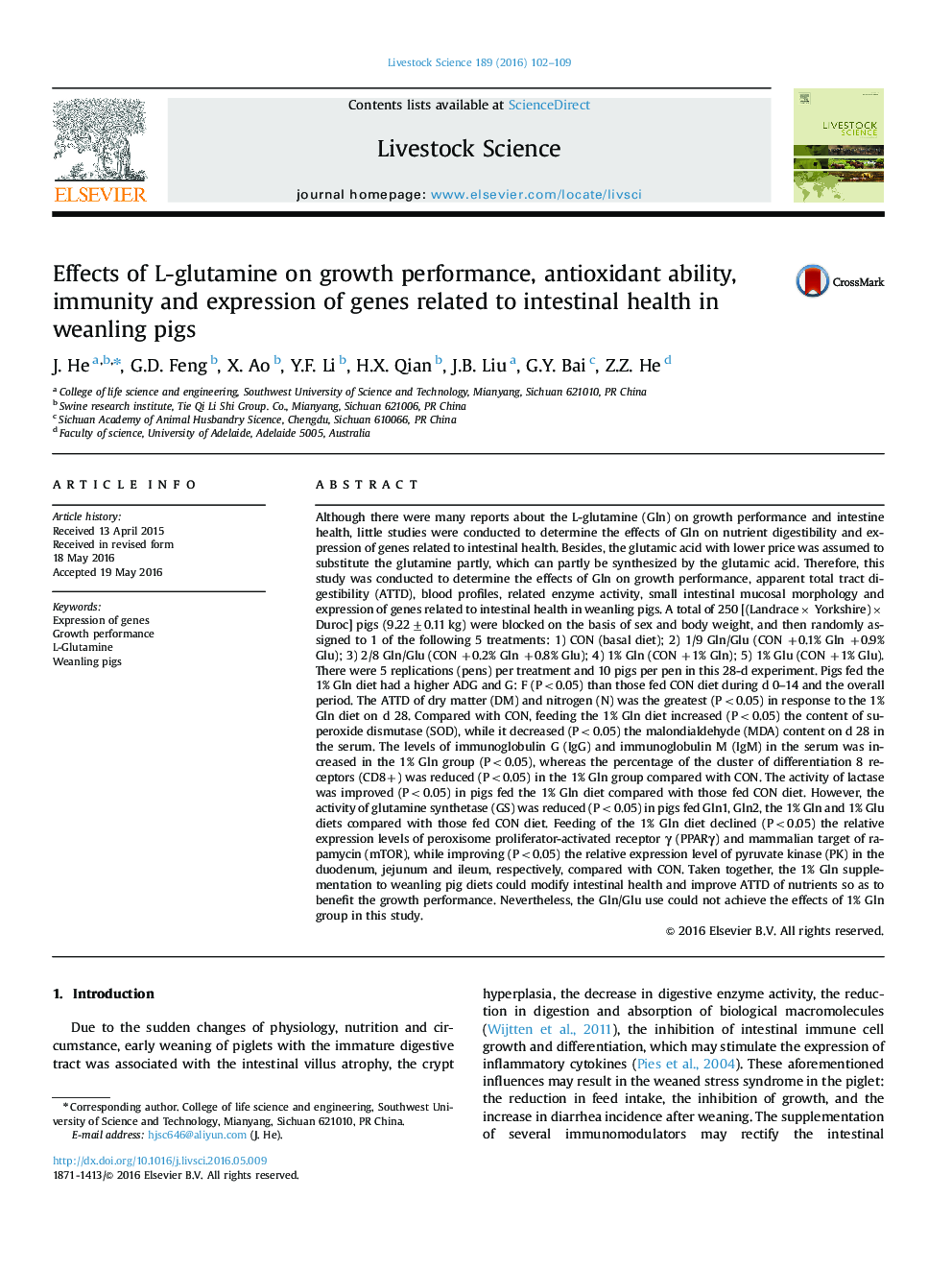| کد مقاله | کد نشریه | سال انتشار | مقاله انگلیسی | نسخه تمام متن |
|---|---|---|---|---|
| 2446919 | 1553943 | 2016 | 8 صفحه PDF | دانلود رایگان |

• Few studies evaluate effects of Gln on genes expression related to intestinal health.
• 1% Gln addition improved growth performance, ATTD of nutrients.
• The activity of jejunum disaccharide enzyme was improved by the addition of 1% Gln.
• 1% Gln regulates the relative expression of intestinal PPARγ, mTOR and PK.
Although there were many reports about the L-glutamine (Gln) on growth performance and intestine health, little studies were conducted to determine the effects of Gln on nutrient digestibility and expression of genes related to intestinal health. Besides, the glutamic acid with lower price was assumed to substitute the glutamine partly, which can partly be synthesized by the glutamic acid. Therefore, this study was conducted to determine the effects of Gln on growth performance, apparent total tract digestibility (ATTD), blood profiles, related enzyme activity, small intestinal mucosal morphology and expression of genes related to intestinal health in weanling pigs. A total of 250 [(Landrace× Yorkshire)× Duroc] pigs (9.22±0.11 kg) were blocked on the basis of sex and body weight, and then randomly assigned to 1 of the following 5 treatments: 1) CON (basal diet); 2) 1/9 Gln/Glu (CON +0.1% Gln +0.9% Glu); 3) 2/8 Gln/Glu (CON +0.2% Gln +0.8% Glu); 4) 1% Gln (CON +1% Gln); 5) 1% Glu (CON +1% Glu). There were 5 replications (pens) per treatment and 10 pigs per pen in this 28-d experiment. Pigs fed the 1% Gln diet had a higher ADG and G: F (P<0.05) than those fed CON diet during d 0–14 and the overall period. The ATTD of dry matter (DM) and nitrogen (N) was the greatest (P<0.05) in response to the 1% Gln diet on d 28. Compared with CON, feeding the 1% Gln diet increased (P<0.05) the content of superoxide dismutase (SOD), while it decreased (P<0.05) the malondialdehyde (MDA) content on d 28 in the serum. The levels of immunoglobulin G (IgG) and immunoglobulin M (IgM) in the serum was increased in the 1% Gln group (P<0.05), whereas the percentage of the cluster of differentiation 8 receptors (CD8+) was reduced (P<0.05) in the 1% Gln group compared with CON. The activity of lactase was improved (P<0.05) in pigs fed the 1% Gln diet compared with those fed CON diet. However, the activity of glutamine synthetase (GS) was reduced (P<0.05) in pigs fed Gln1, Gln2, the 1% Gln and 1% Glu diets compared with those fed CON diet. Feeding of the 1% Gln diet declined (P<0.05) the relative expression levels of peroxisome proliferator-activated receptor γ (PPARγ) and mammalian target of rapamycin (mTOR), while improving (P<0.05) the relative expression level of pyruvate kinase (PK) in the duodenum, jejunum and ileum, respectively, compared with CON. Taken together, the 1% Gln supplementation to weanling pig diets could modify intestinal health and improve ATTD of nutrients so as to benefit the growth performance. Nevertheless, the Gln/Glu use could not achieve the effects of 1% Gln group in this study.
Journal: Livestock Science - Volume 189, July 2016, Pages 102–109